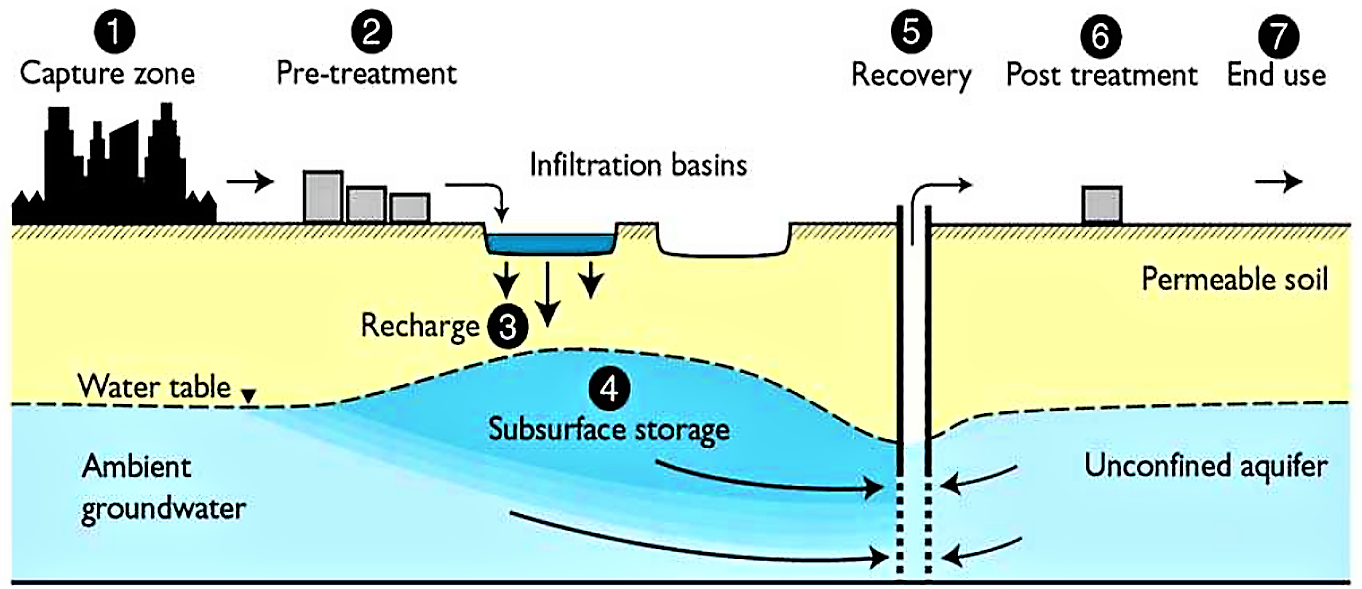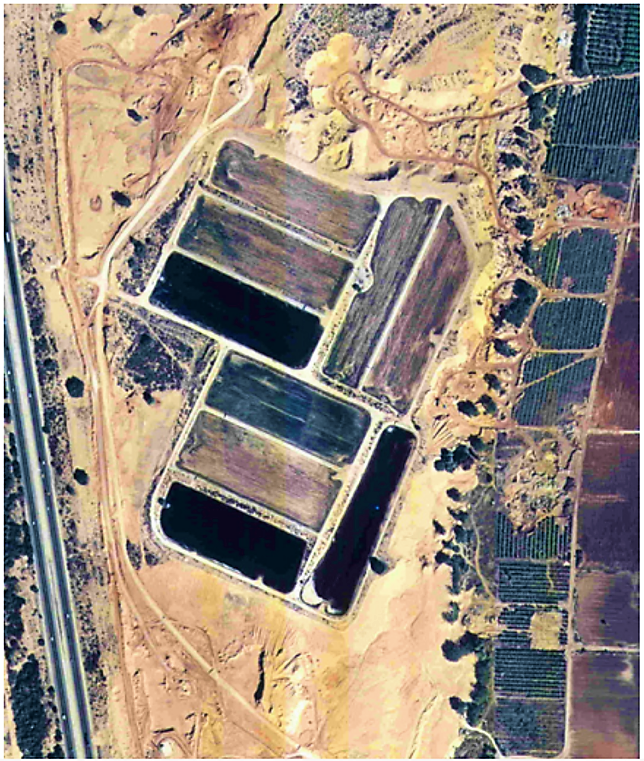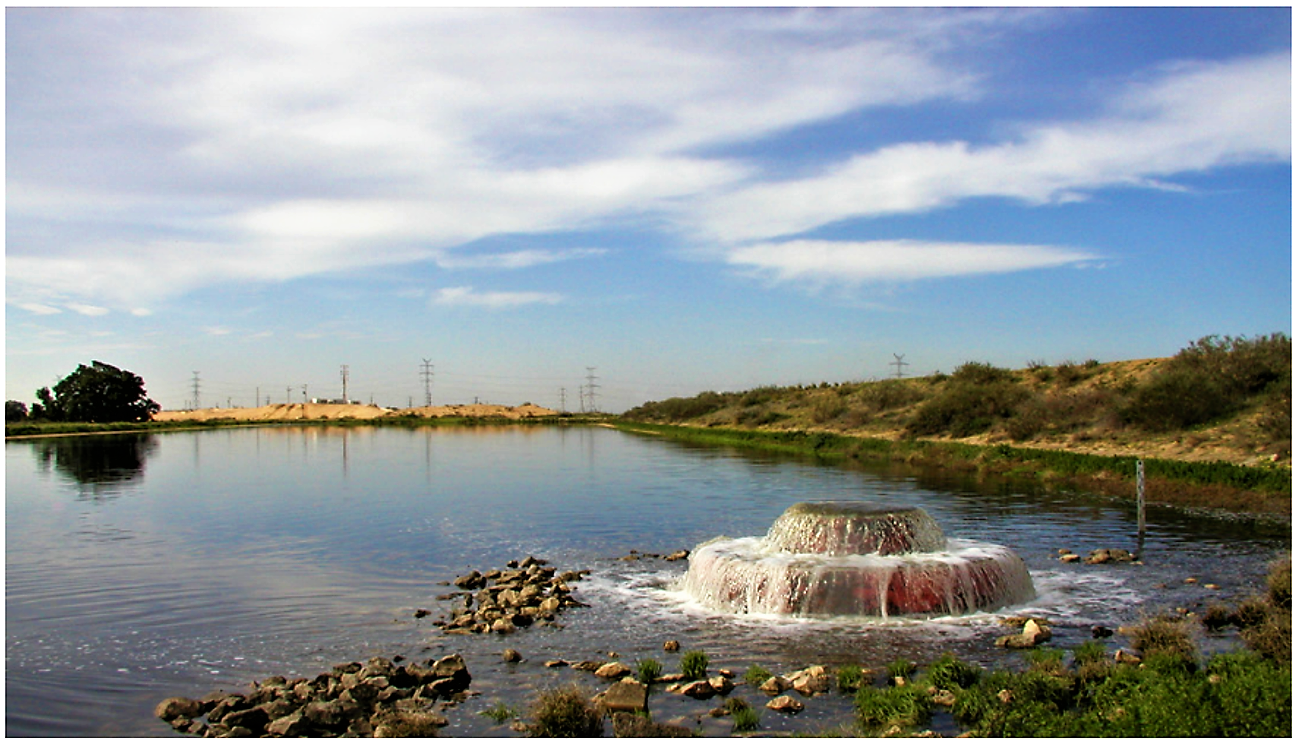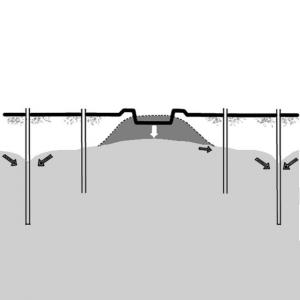Executive Summary
Soil Aquifer Treatment (SAT) is an artificial groundwater aquifer recharge option. Water is introduced into the groundwater through soil percolation under controlled conditions. Soil aquifer treatment is either used to artificially augment the groundwater in order to withdraw freshwater again at a later stage or as a barrier to prevent saltwater or contaminants from entering the aquifer. During percolation, natural soil filtration occurs and the water enters the aquifer where mixing and possibly some other physical and chemical reactions may occur. This method can be used with reclaimed water (treated blackwater) or relatively little polluted water (e.g. pre-treated greywater or stormwater).
| In | Out |
|---|---|
Freshwater |
Introduction
Many cities and agricultural areas rely on the combined use of surface water and groundwater. When demand increases, groundwater is often the most economic source of supply, but overexploitation can lead to the deterioration of water quality or a decreasing groundwater level. Eventually this leads to the depletion of groundwater reserves. Managed Aquifer Recharge (MAR) refers to different recharge techniques that release the reclaimed water from above the ground, percolating through unsaturated soil (see surface groundwater recharge), or from below the ground, by injection or recharge wells (see subsurface groundwater recharge) (CSIRO 2010). The utilisation of alternative water sources is a promising option for integrated water management (MELIN 2009). The added advantage of this method is that reclaimed water such as treated blackwater, greywater or stormwater is not just discharged into other surface waters, but reused as water for irrigation in agriculture or to intentionally recharge groundwater aquifers via MAR. Soil Aquifer Treatment (SAT) is one of many MAR methods, which is receiving growing attention because it features advantages such as inherent natural treatment, inbuilt storage capacity to buffer seasonal variations of supply and demand as well as mixing with natural water bodies, which promotes the acceptance of further uses, particularly indirect potable use (MELIN 2009).
How Does SAT Work?
SAT is one method used to recharge groundwater aquifers from the surface or from below the surface. Typically, SAT is used to enter either stormwater (SHUTES et al. 2010) or pre-treated wastewater (MELIN 2009) through a recharge basin (also: infiltration basin) or an injection well (direct injection, see also surface groundwater recharge) e.g. when space is not available for a recharge basin (see also subsurface groundwater recharge).
As the effluent moves through the soil and the aquifer, it can undergo significant quality improvements through physical, chemical and biological processes. The water is stored in the underlying unconfined aquifer generally for subsequent reuse, such as irrigation or even for drinking water purposes (generally after a water purification step). In short, SAT has benefits both in treatment in the dominated unsaturated zone, which acts like a natural filter and storage within the saturated zone (groundwater aquifer) (MIOTLINSKI et al. 2010).

Depending on the wastewater quality, land availability and intended water supply usage, SAT can be complemented by various pre-treatment technologies such as horizontal, vertical and free-surface constructed wetlands, waste stabilisation ponds, UASB reactor or advanced treatments such as activated sludge, membrane filtration, etc.
The quality of water extracted from a recharge aquifer depends on the quality of the reclaimed water introduced (after pre-treatment), the method of recharge, the characteristics of the aquifer, the residence time, the amount of blending with other waters and the history of the system (TILLEY et al. 2008). Generally it poses challenges with regard to public health (AERTGEERTS and ANGELAKIS 2003; ASANO and COTRUVO 2004). Especially groundwater recharge with recycled wastewater presents a wide range of technical and health challenges (ASANO and COTRUVO 2004). Although the unsaturated part of the soil is known to act as a filter for a variety of contaminants, groundwater recharge should not be viewed as a treatment method (TILLEY et al. 2008).
Impacts and Objectives of SAT
The SAT method can have the following objectives:
Safer Water Storage
Underground water storage can reduce the evaporation rate (especially in arid and semi-arid regions) (MIOTLINSKI et al. 2010), the potential breeding places for insect-vector diseases (especially stormwater drainage) (EAWAG and SANDEC 2008), and risk of contamination and pollution (e.g. algae) compared to water stored on the surface. Taste and odour are also better (ASANO and COTRUVO 2004). Aquifer recharge leads to storage of surplus water for later use. The increased storage capacity buffers seasonal and weather pattern variations of water availability and demand. It is thus a safe and reliable climate change adaptation method to cope with water shortages (PITTOCK et al. 2009).
Mixing Water Flows
SAT enables the mixing of reclaimed and treated water with natural water bodies. This promotes the acceptance of further uses, particularly indirect potable use (MELIN 2009). Because the water is abstracted from wells user acceptance is generally high (ASANO and COTRUVO 2004).
Quality Improvement
SAT is most commonly used to remove residual organic material, nitrogen and pathogenic microorganisms before storing reclaimed water in the aquifer (NCSWS 2001). Using SAT, biological oxygen demand (BOD) can be removed efficiently and ammonia can be effectively nitrified under most conditions. Furthermore, a SAT system effectively removes bacteria and viruses (JIMENEZ 2008). However, denitrification does not readily occur.
Mitigate Saltwater or Contaminants Intrusion
If the groundwater is too salty for use, recharge with fresher water e.g. stormwater will displace the saltier water, help to mitigate or control saltwater intrusion into coastal aquifers, or generally prevent intrusion of contaminants into the aquifer (BIXIO et al. 2006; PITTOCK et al. 2009).
Example: the Shafdan Treatment Plant, Israel
Since the 1970’s, the Shafdan treatment plant (in the El Dan region, central Israel) uses the SAT method. Today it is one of the biggest reclamation sites applying SAT, where the method has ever since adapted to changing conditions (CIKUREL 2006).


The plant infiltrates 130 x 106 m3/year of a biological secondary effluent with nitrogen elimination through a series of open ponds. The cycle lasts four days and the recharge rate is 70–210 m/year. This way, 90% of BOD, Total Suspended Solids (TSS), ammonia, nitrogen, and phosphorus are removed. However there is an increase in salinity, due to the proximity to the coast, and in boron content, due to the type of soil (ORON 2001; JIMENEZ 2008).
| Parameter (mg/l) | Before treatment | After treatment | Removal (%) |
| BOD | 6 | < 0.5 | > 92 |
| COD | 46 | 7 | 85 |
| TSS | 7 | 0 | 100 |
| DOC | 11 | 2.8 | 75 |
| Detergents | 0.241 | < 0.1 | > 55 |
| Mineral oils | 0.4 | 0.3 | 25 |
| Phenols | 4 | 1 | 75 |
| Ammonia as N | 8.2 | < 0.02 | > 99 |
| Total N | 12 | 5.4 | 55 |
| 2.7 | 0.05 | 98 |
Characteristics of Soil Aquifer Treatment in the Shafdan treatment plant (El Dan, central Israel). Source: ORON (2001)
Today, the Shafdan plant applies a short SAT (to prevent production of proteins which lead to clogging of nanofiltration membranes) combined with nanofiltration. This combination of technologies was found to be superior to the conventional SAT technology in terms of land use, time parameters, and water quality. The method enabled quick and efficient removal of microorganisms and micropollutants, resulting in the production of water near drinkable quality and suitable for irrigation use. The process was also found to be superior to the combination of SAT and ultrafiltration, which, although it occupies a smaller land area, is relatively more energy intensive, does not remove all micropollutants, and only produces water quality for irrigation use (LOFTUS 2011).
Adapted from: PHILIP et al (2011); PHEDM (n.y.)
SAT can be applied when facing issues with the quantity and the quality of groundwater aquifers. It can be an option where groundwater levels are declining due to overexploitation, where a substantial part of the aquifer has already been desaturated (e.g. when regeneration of water in wells is slow), or where groundwater from wells is inadequate during the dryer months. Also as another benefit, SAT can contribute to an improvement of the aquifer water.
The suitability of SAT is dependent on the characteristics of the local groundwater and its performance is closely related to local conditions such as the quality of the influent, soil type and purpose of water. They will determine both, the applicability of the technology and the level of required pre- and post-treatment. SAT should not be applied when it can contribute to groundwater deterioration. SAT may also increase the risk of flooding in areas where groundwater levels are already high.
Typical SAT systems require a large surface area to allow the infiltration of the wastewater into the aquifer. In many cities the required land is costly and often unavailable due to high population densities and covered land. Alternative SAT technologies, that require much less land area, are however being investigated (e.g. “Short SAT – Nanofiltration”, LOFTUS 2011).
According to surveys, the best water reuse projects in terms of economic viability and public acceptance are those that substitute potable water with reclaimed water for use in irrigation, environmental restoration, cleaning, sanitation and industrial uses (PITTOCK et al. 2009). In Europe, much of the municipal wastewater reuse has only occurred in the coastline and islands of the semi-arid southern regions so far, and in the highly urbanised areas of the wetter northern parts. In southern Europe reclaimed wastewater is predominantly used for agricultural irrigation, whereas in northern Europe it is mainly used for urban or environmental application and industrial use such as industrial cooling (BIXIO et al. 2006).
Health Risks in Aquifer Recharge Using Reclaimed Water. State of the Art Report
Groundwater Recharge with Reclaimed Municipal Wastewater. Health and Regulatory Considerations
Groundwater and Rural Water Supply in Africa
The Millennium Development Goals (MDGs) for water will only be achieved in Africa by increased development of groundwater for rural water supply. However,the role that groundwater plays in achieving the MDGs is underrated and rarely articulated. This briefing note explores the main groundwater issues related to rural water supply in Africa.
BGN (2006): Groundwater and Rural Water Supply in Africa. International Association of Hydrogeologists (IAH) Burdon Groundwater Network (BGN) URL [Accessed: 26.05.2019]Wastewater Reuse in Europe
Future Scenarios for Soil Aquifer Treatment: Responding to Change. SWITCH Project Workshop on Learning Alliance
This presentation provides information on the SAT system in the Dan Region (central Israel) and its importance and potential for water reclamation in Israel.
CIKUREL, H. (2006): Future Scenarios for Soil Aquifer Treatment: Responding to Change. SWITCH Project Workshop on Learning Alliance. Tel Aviv: Mekorot URL [Accessed: 11.08.2011]Managed Aquifer Recharge. Frequently Asked Questions
Brief factsheet giving an oversight over most common managed aquifer recharge methods. With an Australian perspective.
CSIRO (2010): Managed Aquifer Recharge. Frequently Asked Questions. Commonwealth Scientific and Industrial Research Organisation (CSIRO) URL [Accessed: 26.05.2019]Environmental Health. Lecture notes
This book contains information on environmental health aspects of water and sanitation. It contains a definition of environmental health, describes various water-related diseases and also hygiene approaches. There is also a related PowerPoint to this document.
EAWAG ; SANDEC (2008): Environmental Health. Lecture notes. (= Sandec Training Tool 1.0, Module 2 ). Duebendorf: Swiss Federal Institute of Aquatic Science (EAWAG), Department of Water and Sanitation in Developing Countries (SANDEC) URL [Accessed: 23.05.2012]Water Reuse. An International Survey of Current Practice, Issues and Needs
Health Risk in Aquifer Recharge with Recycled Water
Tel Aviv, Israel. Treating Wastewater for Reuse Using Natural Systems. SWITCH Training Kit Case Study
This case study includes the challenges the Shafdan treatment plant in Israel has experienced since the 1970’s; the new technologies that are applied and the lessons learned.
LOFTUS, A.C. (2011): Tel Aviv, Israel. Treating Wastewater for Reuse Using Natural Systems. SWITCH Training Kit Case Study. Freiburg: ICLEI European Secretariat GmbH URL [Accessed: 24.08.2011]Reclaim Water. Water Reclamation Technologies for Safe Artificial Groundwater Recharge. Publishable Final Activity Report
This report presents results from eight technical pilot studies on aquifer recharge (including SAT) between 2005 and 2008 on five continents. The main objective of these studies was to assess the overall performance of these sites in recharging aquifers mainly for irrigation and potable water supply purposes by following contaminant fate throughout each scheme.
MELIN, T. (2009): Reclaim Water. Water Reclamation Technologies for Safe Artificial Groundwater Recharge. Publishable Final Activity Report. Aachen: RWTH Aachen University URL [Accessed: 26.05.2019]Alice Springs SAT Project Hydrological and Water Quality Monitoring Report 2008-2009
This study conducted in Alice Springs, the arid zone of central Australia, evaluated the performance of the SAT method, in particular rates of infiltration and changes in groundwater quality. It found that attenuation of nitrogen is low because the soil beneath the basin is aerobic and denitrification is inhibited. The report features many technical details and data analysis.
MIOTLINSKI, K. BARRY, K. DILLON, P. (2010): Alice Springs SAT Project Hydrological and Water Quality Monitoring Report 2008-2009. CSIRO Water for a Healthy Country National Research Flagship URL [Accessed: 10.08.2011]Investigation on Soil-Aquifer Treatment for Sustainable Water Reuse. Research Project Summary
Management of Effluent Reclamation via Soil Aquifer Treatment Procedures. Consultation on Health Risks in Aquifer Recharge by Recycled Water, Budapest
Chapter 9: Artificial Groundwater Recharge
This is a chapter on a rainwater-harvesting manual from the Public Health Engineering Department in India. It gives an extensive overview on different groundwater recharge technologies and approaches.
PHEDM (n.y): Chapter 9: Artificial Groundwater Recharge. In: PHEDM (n.y): Rain Water Harvesting ManuaI. Meghalaya State Centre, India: . URL [Accessed: 26.05.2019]Wastewater – Exploring the Options. Switch Training Kit Module 5. Integrated Urban Water Management in the City of the Future
This training module assists to gain a better understanding of what generates a more sustainable approach to wastewater management, why it should not be considered as a waste product and how it can be used as a resource, including the use of natural systems. More information: http://www.switchtraining.eu/modules/module-5/
PHILIP, R. ; ANTON, B. ; SALIAN, P. ; LOFTUS, A.C. (2011): Wastewater – Exploring the Options. Switch Training Kit Module 5. Integrated Urban Water Management in the City of the Future. Freiburg: ICLEI European Secretariat GmbH URL [Accessed: 22.08.2011]Interbasin Water Transfers and Water Scarcity in a Changing World – a Solution or a Pipedream? Frankfurt a
Constructed Wetlands for Flood Prevention and Water Reuse
Compendium of Sanitation Systems and Technologies
This compendium gives a systematic overview on different sanitation systems and technologies and describes a wide range of available low-cost sanitation technologies.
TILLEY, E., LUETHI, C., MOREL, A., ZURBRUEGG, C. and SCHERTENLEIB, R. (2008): Compendium of Sanitation Systems and Technologies. Duebendorf, Switzerland: Swiss Federal Institute of Aquatic Science and Technology (EAWAG) and Water Supply and Sanitation Collaborative Council (WSSCC) URL [Accessed: 15.02.2010] PDFFuture Scenarios for Soil Aquifer Treatment: Responding to Change. SWITCH Project Workshop on Learning Alliance
This presentation provides information on the SAT system in the Dan Region (central Israel) and its importance and potential for water reclamation in Israel.
CIKUREL, H. (2006): Future Scenarios for Soil Aquifer Treatment: Responding to Change. SWITCH Project Workshop on Learning Alliance. Tel Aviv: Mekorot URL [Accessed: 11.08.2011]Managed Aquifer Recharge. Frequently Asked Questions
Brief factsheet giving an oversight over most common managed aquifer recharge methods. With an Australian perspective.
CSIRO (2010): Managed Aquifer Recharge. Frequently Asked Questions. Commonwealth Scientific and Industrial Research Organisation (CSIRO) URL [Accessed: 26.05.2019]Health Risk in Aquifer Recharge with Recycled Water
Management of aquifer recharge and discharge processes and aquifer storage equilibrium
This paper draws attention to case studies from a range of hydro-geological, climatic and societal settings where innovative management has been successful in reversing groundwater storage declines (or increases). Informing and engaging stakeholders in governance has resulted in more resilient outcomes that take better account of local needs. Importantly, in many settings local action by motivated communities has run ahead of state and national policies and been highly effective in managing groundwater storage, increasing farm incomes and protecting the environment.
FAO GEF IAH IHP World Bank (2012): Management of aquifer recharge and discharge processes and aquifer storage equilibrium. Food and Agriculture Organization (FAO) URL [Accessed: 08.04.2013]Selected contributions from the 1st WATERBIOTECH conference, 9-11 October 2012, Cairo, Egypt
This issue publishes selected contributions from the 1st WATERBIOTECH conference. WATERBIOTECH („Biotechnology for Africa‘s sustainable water supply“) is a coordination and support action funded within the Africa call of the EU 7th Framework Programme.
ECOSAN CLUB (2013): Selected contributions from the 1st WATERBIOTECH conference, 9-11 October 2012, Cairo, Egypt. (= Sustainable Sanitation Pratice , 14 ). Vienna: Ecosan Club URL [Accessed: 29.01.2013]Tel Aviv, Israel. Treating Wastewater for Reuse Using Natural Systems. SWITCH Training Kit Case Study
This case study includes the challenges the Shafdan treatment plant in Israel has experienced since the 1970’s; the new technologies that are applied and the lessons learned.
LOFTUS, A.C. (2011): Tel Aviv, Israel. Treating Wastewater for Reuse Using Natural Systems. SWITCH Training Kit Case Study. Freiburg: ICLEI European Secretariat GmbH URL [Accessed: 24.08.2011]Reclaim Water. Water Reclamation Technologies for Safe Artificial Groundwater Recharge. Publishable Final Activity Report
This report presents results from eight technical pilot studies on aquifer recharge (including SAT) between 2005 and 2008 on five continents. The main objective of these studies was to assess the overall performance of these sites in recharging aquifers mainly for irrigation and potable water supply purposes by following contaminant fate throughout each scheme.
MELIN, T. (2009): Reclaim Water. Water Reclamation Technologies for Safe Artificial Groundwater Recharge. Publishable Final Activity Report. Aachen: RWTH Aachen University URL [Accessed: 26.05.2019]Alice Springs SAT Project Hydrological and Water Quality Monitoring Report 2008-2009
This study conducted in Alice Springs, the arid zone of central Australia, evaluated the performance of the SAT method, in particular rates of infiltration and changes in groundwater quality. It found that attenuation of nitrogen is low because the soil beneath the basin is aerobic and denitrification is inhibited. The report features many technical details and data analysis.
MIOTLINSKI, K. BARRY, K. DILLON, P. (2010): Alice Springs SAT Project Hydrological and Water Quality Monitoring Report 2008-2009. CSIRO Water for a Healthy Country National Research Flagship URL [Accessed: 10.08.2011]Stormwater – Exploring the Options. Switch Training Kit Module 4. Integrated Urban Water Management in the City of the Future
This training module on stormwater focuses on direct and indirect benefits that urban areas can gain by managing stormwater as a resource rather than as a restriction to urban development. It also includes a section with solutions available for integrated urban water management. More information: http://www.switchtraining.eu/modules/module-4/
PHILIP, R. ; ANTON, B. ; LOFTUS, A.C. (2011): Stormwater – Exploring the Options. Switch Training Kit Module 4. Integrated Urban Water Management in the City of the Future. Freiburg: ICLEI European Secretariat GmbH URL [Accessed: 22.08.2011]Wastewater – Exploring the Options. Switch Training Kit Module 5. Integrated Urban Water Management in the City of the Future
This training module assists to gain a better understanding of what generates a more sustainable approach to wastewater management, why it should not be considered as a waste product and how it can be used as a resource, including the use of natural systems. More information: http://www.switchtraining.eu/modules/module-5/
PHILIP, R. ; ANTON, B. ; SALIAN, P. ; LOFTUS, A.C. (2011): Wastewater – Exploring the Options. Switch Training Kit Module 5. Integrated Urban Water Management in the City of the Future. Freiburg: ICLEI European Secretariat GmbH URL [Accessed: 22.08.2011]Impacts of Water-management Decisions on the Survival of a City. From Ancient Tenochtitlan to Modern Mexico City
This article analyses how water-management policies have developed over the centuries, how these policies have affected the city’s inhabitants, and the environment. The study uses the history of water management decisions and practices in Mexico City as an example. It also points out relevant future directions for water policy.
SOSA-RODRIGUEZ, F. (2010): Impacts of Water-management Decisions on the Survival of a City. From Ancient Tenochtitlan to Modern Mexico City. Waterloo: University of Waterloo URL [Accessed: 26.05.2019]Wastewater use in aquaculture
The FAO homepage provides an online document on wastewater treatment and use in agriculture with an extra chapter on wastewater use in aquaculture. Various economical, ecological, technical and biological aspects are explained.
SWITCH Case studies
This page contains case studies of some of these SWITCH cities, but also of other cities that exemplify good practice of the approaches, options and technologies laid out in the SWITCH Training Kit modules.
International Association of Hydrogeologists
The research page of the International Association of Hydrogeologists (IAH) features many publications on groundwater research.


